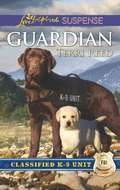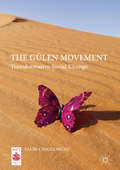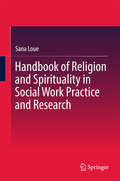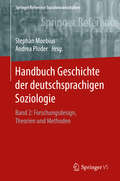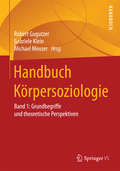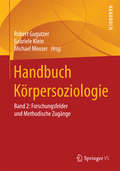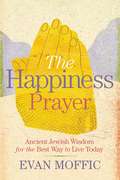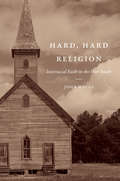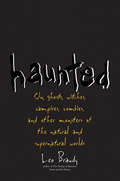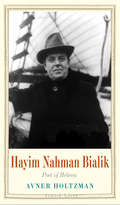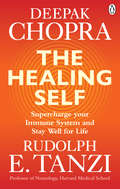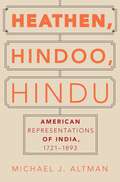- Table View
- List View
Growth and Decline in the Anglican Communion: 1980 to the Present (Routledge Contemporary Ecclesiology)
by David GoodhewThe Anglican Communion is one of the largest Christian denominations in the world. Growth and Decline in the Anglican Communion is the first study of its dramatic growth and decline in the years since 1980. An international team of leading researchers based across five continents provides a global overview of Anglicanism alongside twelve detailed case studies. The case studies stretch from Singapore to England, Nigeria to the USA and mostly focus on non-western Anglicanism. This book is a critical resource for students and scholars seeking an understanding of the past, present and future of the Anglican Church. More broadly, the study offers insight into debates surrounding secularisation in the contemporary world.
Guardian: Protection Detail Duty Bound Guardian (Classified K-9 Unit #1)
by Terri ReedPROTECTING THE SINGLE MOM
The Gülen Movement: Transformative Social Change
by Salih CıngıllıoğluThis book presents findings from research into one of the world's most influential Islamic movements, the Gülen Movement, from the perspective of social transformation through adult education. At the core of research questions lies how the movement enrolls volunteers from all walks of life and transforms them to adopt its aims at the expense of their individual ideals. The book reveals the socio-psychological mechanisms that make such transformation possible by looking at how followers integrate weekly lectures and discussions on the theory and practice of Islam into their personal and social lives. The Gülen Movement offers a moderate interpretation of Islam and stresses the vitality of establishing communication with the members of all faiths. This book provides a window into how and why religion may roll into extremism by presenting findings from an opposite perspective: the participants in the research all define themselves as truly pious but do not even imply an act of violence in tens of hours of interviews. In short, the book weaves the strands of "Islamic," "movement," and "adult education" into a unified whole and limns the snapshot of a social movement, offering a comprehensive discussion of the role of adult education within the movement, as well as its transformative potential and its wider social and political implications.
The Gülen Movement: Transformative Social Change
by Salih CıngıllıoğluThis book presents findings from research into one of the world's most influential Islamic movements, the Gülen Movement, from the perspective of social transformation through adult education. At the core of research questions lies how the movement enrolls volunteers from all walks of life and transforms them to adopt its aims at the expense of their individual ideals. The book reveals the socio-psychological mechanisms that make such transformation possible by looking at how followers integrate weekly lectures and discussions on the theory and practice of Islam into their personal and social lives. The Gülen Movement offers a moderate interpretation of Islam and stresses the vitality of establishing communication with the members of all faiths. This book provides a window into how and why religion may roll into extremism by presenting findings from an opposite perspective: the participants in the research all define themselves as truly pious but do not even imply an act of violence in tens of hours of interviews. In short, the book weaves the strands of "Islamic," "movement," and "adult education" into a unified whole and limns the snapshot of a social movement, offering a comprehensive discussion of the role of adult education within the movement, as well as its transformative potential and its wider social and political implications.
Handbook of Religion and Spirituality in Social Work Practice and Research
by Sana LoueThis singular reference explores religion and spirituality as a vital, though often misconstrued, lens for building better understanding of and empathy with clients. A diverse palette of faiths and traditions is compared and contrasted (occasionally with secularism), focusing on areas of belief that may inspire, comfort, or trouble clients, including health and illness, mental illness, healing, coping, forgiveness, family, inclusion, and death. From assessment and intervention planning to conducting research, these chapters guide professionals in supporting and assisting clients without minimizing or overstating their beliefs. In addition, the book’s progression of ideas takes readers beyond the well-known concept of cultural competence to model a larger and more meaningful cultural safety.Among the topics included in the Handbook:Integrating religion and spirituality into social work practice. Cultural humility, cultural safety, and beyond: new understandings and implications for social work.Healing traditions, religion/spirituality, and health.Diagnosis: religious/spiritual experience or mental illness?Understandings of dying, death, and mourning. (Re)building bridges in and with family and community.Ethical issues in conducting research on religion and spirituality.The Handbook of Religion and Spirituality in Social Work Practice and Research is a richly-textured resource for social workers and mental health professionals engaged in clinical practice and/or research seeking to gain varied perspectives on how the religion and spirituality of their clients/research participants may inform their work.
Handbuch Diskriminierung (Springer Reference Sozialwissenschaften)
by Albert Scherr Aladin El-Mafaalani Gökçen YükselIn diesem Band wird das gesellschaftspolitisch bedeutsame Themenfeld Diskriminierung umfassend dargestellt. Dabei wird von einem interdisziplinär tragfähigen Begriffsverständnis ausgegangen. Dargestellt werden der Stand der Forschung der relevanten wissenschaftlichen Disziplinen sowie Konzepte und Forschungsergebnisse zur Diskriminierung in gesellschaftlichen Teilsystemen und in Bezug auf Gruppen- und Personenkategorien. Aufgezeigt werden zudem Anti-Diskriminierungsstrategien und Institutionen der Anti-Diskriminierungspraxis. Damit ermöglicht das Handbuch einen fundierten Überblick sowie thematische Vertiefungen und stellt Grundlagen für die wissenschaftliche Forschung und für die politische Diskussion zur Verfügung.
Handbuch Evangelikalismus (Religionswissenschaft #5)
by Frederik Elwert Martin Radermacher Jens SchlamelcherDie Evangelikalen sind eine der am schnellsten wachsenden religiösen Bewegungen weltweit und gewinnen zunehmend auch im deutschsprachigen Raum an Bedeutung. Dieses Handbuch vermittelt erstmals in deutscher Sprache einen Gesamtüberblick über die christlichen Gruppen, die im weitesten Sinne unter dem Begriff »Evangelikalismus« zusammengefasst werden können. Nach einführenden Kapiteln zu Begriff und Forschungsstand erläutern führende Expert_innen die Geschichte und globale Ausbreitung evangelikaler Gruppen. Systematisch werden Lehre und Praxis dieser christlichen Glaubensformen dargestellt und Sozialformen sowie Verflechtungen mit gesellschaftlichen Funktionsbereichen (z.B. Wirtschaft, Politik und Wissenschaft) beleuchtet.
Handbuch Geschichte der deutschsprachigen Soziologie: Band 2: Forschungsdesign, Theorien und Methoden (Springer Reference Sozialwissenschaften)
by Stephan Moebius Andrea PloderWer sich einen Überblick über die Geschichte der deutschsprachigen Soziologie und über soziologiehistorische Konzepte und Methoden verschaffen möchte, wird in diesem zweibändigen Handbuch umfassend fündig. Band 2 widmet sich soziologiegeschichtlichen Forschungsdesigns, analytischen Konzepten sowie unterschiedlichen Methodologien und Methoden für die soziologiehistorische Forschung. Er bietet auch einen praxisorientierten Teil zur Arbeit in und mit Archiven. Insgesamt dient Band 2 als ein Werkzeugkasten für systematische soziologiehistorische Forschung.
Handbuch Körpersoziologie: Band 1: Grundbegriffe und theoretische Perspektiven
by Robert Gugutzer Gabriele Klein Michael MeuserDas Handbuch Körpersoziologie verfolgt das Ziel, den grundlegenden Stellenwert des Körpers für soziologisches Denken zu veranschaulichen. Die Körpersoziologie versteht den Körper als bedeutsam für subjektiv sinnhaftes Handeln sowie als eine soziale Tatsache, die hilft, Soziales zu erklären. Der menschliche Körper ist Produzent, Instrument und Effekt des Sozialen. Er ist gesellschaftliches und kulturelles Symbol sowie Agent, Medium und Instrument sozialen Handelns. Soziale Strukturen schreiben sich in den Körper ein, soziale Ordnung wird im körperlichen Handeln und Interagieren hergestellt. Sozialer Wandel wird durch körperliche Empfindungen motiviert und durch körperliche Aktionen gestaltet. Körpersoziologie ist in diesem Sinne als verkörperte Soziologie zu verstehen.Das Handbuch Körpersoziologie dokumentiert das breite Spektrum an körpersoziologischen Perspektiven und Ansätzen und den aktuellen Status Quo der Körpersoziologie. Band 1 präsentiert eine Übersicht zentraler körpersoziologischer Grundbegriffe sowie die Perspektiven einer Vielzahl soziologischer Theorien auf den Körper.
Handbuch Körpersoziologie: Band 2: Forschungsfelder und Methodische Zugänge
by Robert Gugutzer Gabriele Klein Michael MeuserDas Handbuch Körpersoziologie verfolgt das Ziel, den grundlegenden Stellenwert des Körpers für soziologisches Denken zu veranschaulichen. Die Körpersoziologie versteht den Körper als bedeutsam für subjektiv sinnhaftes Handeln sowie als eine soziale Tatsache, die hilft, Soziales zu erklären. Der menschliche Körper ist Produzent, Instrument und Effekt des Sozialen. Er ist gesellschaftliches und kulturelles Symbol sowie Agent, Medium und Instrument sozialen Handelns. Soziale Strukturen schreiben sich in den Körper ein, soziale Ordnung wird im körperlichen Handeln und Interagieren hergestellt. Sozialer Wandel wird durch körperliche Empfindungen motiviert und durch körperliche Aktionen gestaltet. Körpersoziologie ist in diesem Sinne als verkörperte Soziologie zu verstehen.Das Handbuch Körpersoziologie dokumentiert das breite Spektrum an körpersoziologischen Perspektiven und Ansätzen und den aktuellen Status Quo der Körpersoziologie. Band 2 präsentiert eine Vielzahl soziologischer Forschungsfelder und methodischer Zugänge und belegt damit die soziologische Relevanz des Körpers unter erkenntnis-, und sozialtheoretischen, methodologischen und methodischen Gesichtspunkten.
Hannah’s Song: What Love Looks Like
by Diana HageeJoin Diana Hagee in this insightful Bible study as she takes you verse by verse through the story of Hannah memorialized in 1 Samuel. Hannah endured heartache, frustration, and a deep feeling of inadequacy for being barren in a culture that honored motherhood. Still, she was a woman of patience, perseverance, and courage. Hannah cried out to God with absolute faith that He would hear her petition and answer it. Using Scripture, powerful storytelling, and real-life examples, this study will help you: Establish a foundation of Bible knowledge Search the Word for answers to everyday life Challenge yourself to dig deeper into the Bible individually or with a group Reflect on God's Word to understand His divine plan for you. Discover that God's Word is approachable, and it should be approached daily. Equip you to live the victorious, committed life of a believer. Hannah's story emphasizes the power of prayer, faith, and praise. Like Hannah, God has a divine plan for every woman. He will pour out His unconditional love on your life as you seek to serve and glorify Him.
Hans Mol and the Sociology of Religion (Routledge Studies in Religion)
by Adam J. PowellHans Mol was born in the Netherlands during the 1920s. His imprisonment by the Gestapo during World War II began a long intellectual journey, exploring the role of religion in society. His work on the sociology of religion throughout the 20th and 21st Century is distinctive in its quest for both methodological and existential balance Part One of this book includes a brief outline of Mol’s most influential theory as originally explicated in Identity and the Sacred (1976). This is followed by a look at the initial reception of that theory in relation to the competing concepts of Mol’s contemporaries. Part Two is comprised of four previously-unpublished essays written by Mol during the 70s and 80s. Covering topics from evolution to evangelicalism, the papers display the sweeping ambition of this sociologist as well as the tone and contours of his intellectual articulation. In the Postscript this volume concludes with select transcripts of interviews conducted between Adam Powell and Hans Mol during the Spring of 2012. This volume of Mol’s work will be of keen interest to academics and students with an interest in the sociology of religion post-World War II and the development of contemporary Christian theology.
Hans Mol and the Sociology of Religion (Routledge Studies in Religion)
by Adam J. PowellHans Mol was born in the Netherlands during the 1920s. His imprisonment by the Gestapo during World War II began a long intellectual journey, exploring the role of religion in society. His work on the sociology of religion throughout the 20th and 21st Century is distinctive in its quest for both methodological and existential balance Part One of this book includes a brief outline of Mol’s most influential theory as originally explicated in Identity and the Sacred (1976). This is followed by a look at the initial reception of that theory in relation to the competing concepts of Mol’s contemporaries. Part Two is comprised of four previously-unpublished essays written by Mol during the 70s and 80s. Covering topics from evolution to evangelicalism, the papers display the sweeping ambition of this sociologist as well as the tone and contours of his intellectual articulation. In the Postscript this volume concludes with select transcripts of interviews conducted between Adam Powell and Hans Mol during the Spring of 2012. This volume of Mol’s work will be of keen interest to academics and students with an interest in the sociology of religion post-World War II and the development of contemporary Christian theology.
The Happiness Prayer: Ancient Jewish Wisdom for the Best Way to Live Today
by Evan Mofficp.p1 {margin: 0.0px 0.0px 0.0px 0.0px; font: 13.0px Times; -webkit-text-stroke: #000000} p.p2 {margin: 0.0px 0.0px 0.0px 28.8px; text-indent: -24.0px; font: 13.0px Times; -webkit-text-stroke: #000000} span.s1 {font-kerning: none} span.s2 {font: 13.0px 'Lucida Grande'; font-kerning: none} span.s3 {font: 9.0px 'Times New Roman'; font-kerning: none} At age 30 Evan Moffic became the leader of a large congregation. He had great success. But he couldn't find happiness. Then he found a 2000-year-old prayer. In it were hidden elements of Jewish wisdom. They became a part of his life and those of his congregation and transformed them and him.What if we had a clear path to follow when life disappointed us? What if we had a time-tested guide for a life of deeper meaning and happiness? That is what Rabbi Moffic discovered in an ancient Jewish prayer.Based on ten practices any person can follow, the prayer has helped thousands of people-couples, teenagers, empty nesters struggling with loss, divorce, and ruptured relationships-find renewed meaning and purpose in their lives.Moffic discovered the power of the prayer when he was called to become the youngest rabbi to lead a large US synagogue at just thirty years of age. The prayer became his guidepost, providing him with the wisdom to lead beyond his years. By incorporating the power of this prayer into his life and using it to guide his congregation and community, he became known as "the smiling rabbi."In the tradition of Rabbi Harold Kushner, Rabbi Evan Moffic opens up the Jewish wisdom tradition with insights for today. Drawing from interactions with thousands of congregants, as well as his own experience; relating stories of real people; providing accessible commentary from contemporary psychologists; and sprinkling in warm humor, this rabbi of a new generation reveals the means and meaning of joyous living that will appeal to everyone. p.p1 {margin: 0.0px 0.0px 0.0px 0.0px; font: 13.0px Times; -webkit-text-stroke: #000000} p.p2 {margin: 0.0px 0.0px 0.0px 28.8px; text-indent: -24.0px; font: 13.0px Times; -webkit-text-stroke: #000000} span.s1 {font-kerning: none} span.s2 {font: 13.0px 'Lucida Grande'; font-kerning: none} span.s3 {font: 9.0px 'Times New Roman'; font-kerning: none}
The Happiness Prayer: Ancient Jewish Wisdom for the Best Way to Live Today
by Evan MofficAt age 30 Evan Moffic became the leader of a large congregation. He had great success. But he couldn't find happiness. Then he found a 2000-year-old prayer. In it were hidden elements of Jewish wisdom. They became a part of his life and those of his congregation and transformed them and him.What if we had a clear path to follow when life disappointed us? What if we had a time-tested guide for a life of deeper meaning and happiness? That is what Rabbi Moffic discovered in an ancient Jewish prayer.Based on ten practices any person can follow, the prayer has helped thousands of people-couples, teenagers, empty nesters struggling with loss, divorce, and ruptured relationships-find renewed meaning and purpose in their lives.Moffic discovered the power of the prayer when he was called to become the youngest rabbi to lead a large US synagogue at just thirty years of age. The prayer became his guidepost, providing him with the wisdom to lead beyond his years. By incorporating the power of this prayer into his life and using it to guide his congregation and community, he became known as "the smiling rabbi."In the tradition of Rabbi Harold Kushner, Rabbi Evan Moffic opens up the Jewish wisdom tradition with insights for today. Drawing from interactions with thousands of congregants, as well as his own experience; relating stories of real people; providing accessible commentary from contemporary psychologists; and sprinkling in warm humor, this rabbi of a new generation reveals the means and meaning of joyous living that will appeal to everyone.
Hard, Hard Religion: Interracial Faith in the Poor South (New Directions in Southern Studies)
by John HayesIn his captivating study of faith and class, John Hayes examines the ways folk religion in the early twentieth century allowed the South's poor--both white and black--to listen, borrow, and learn from each other about what it meant to live as Christians in a world of severe struggle. Beneath the well-documented religious forms of the New South, people caught in the region's poverty crafted a distinct folk Christianity that spoke from the margins of capitalist development, giving voice to modern phenomena like alienation and disenchantment. Through haunting songs of death, mystical tales of conversion, grassroots sacramental displays, and an ethic of neighborliness, impoverished folk Christians looked for the sacred in their midst and affirmed the value of this life in this world. From Tom Watson and W. E. B. Du Bois over a century ago to political commentators today, many have ruminated on how, despite material commonalities, the poor of the South have been perennially divided by racism. Through his excavation of a folk Christianity of the poor, which fused strands of African and European tradition into a new synthesis, John Hayes recovers a historically contingent moment of interracial exchange generated in hardship.
Hasidic Studies: Essays in History and Gender (The Littman Library of Jewish Civilization)
by Ada Rapoport-AlbertAda Rapoport-Albert has been a key player in the profound transformation of the history of hasidism that has taken shape since the 1970s. She has never lacked the courage to question conventional wisdom, but neither has she overturned it lightly. The essays in this volume show the erudition and creativity of her contribution to rewriting the master-narrative of hasidic history. Thanks to her we now know that eighteenth-century hasidism evolved in a context of intense spirituality rather than political, social, economic, or religious crisis. It did not represent the movement’s ‘classic period’ and was not a project of democratization, ameliorating the hierarchical structuring of religion and spirituality. Eighteenth-century hasidism is more accurately described as the formative and creative prelude to the mature movement of the nineteenth century: initially neither institutionalized nor centralized, it developed through a process of differentiation from traditional ascetic-mystical hasidism. Its elite leaders only became conscious of a distinctive group identity after the Ba’al Shem Tov’s death, and they subsequently spent the period from the late eighteenth to the early nineteenth century experimenting with various forms of doctrine, literature, organization, leadership, and transfer of authority. Somewhat surprisingly there was no attempt to introduce any revision of women’s status and role; in the examination of this area of hasidism Rapoport-Albert’s contribution has been singularly revealing. Her work has emphasized that, contrary to hasidism’s thrust towards spiritualization of the physical, the movement persisted in identifying women with an irredeemable materiality: women could never escape their inherent sexuality and attain the spiritual heights. Gender hierarchy therefore persisted and, formally speaking, for the first 150 years or so of hasidism’s existence women were not counted as members of the group. Twentieth-century Habad hasidim responded to modernist feminism by re-evaluating the role of women, but just as Habad appropriated modern rhetorical strategies to defend tradition, so it adopted certain feminist postulates in order to create a counter-feminism that would empower women without destabilizing traditional gender roles. The essays in this volume are a fitting statement of Professor Rapoport-Albert’s importance to the study of hasidism, to Jewish studies as a whole, and to the academic scrutiny of religion. Written over a period of forty years, they have been updated for this volume with regard to significant detail and to take account of important works of scholarship written after they were originally published.
Haunted: On Ghosts, Witches, Vampires, Zombies, and Other Monsters of the Natural and Supernatural Worlds
by Leo BraudyAn award-winning scholar and author charts four hundred years of monsters and how they reflect the culture that created them Leo Braudy, a finalist for both the National Book Award and the National Book Critics Circle Award, has won accolades for revealing the complex and constantly shifting history behind seemingly unchanging ideas of fame, war, and masculinity. Continuing his interest in the history of emotion, this book explores how fear has been shaped into images of monsters and monstrosity. From the Protestant Reformation to contemporary horror films and fiction, he explores four major types: the monster from nature (King Kong), the created monster (Frankenstein), the monster from within (Mr. Hyde), and the monster from the past (Dracula). Drawing upon deep historical and literary research, Braudy discusses the lasting presence of fearful imaginings in an age of scientific progress, viewing the detective genre as a rational riposte to the irrational world of the monstrous. Haunted is a compelling and incisive work by a writer at the height of his powers.
Hauntings
by Paul RolandPacked with chilling true stories and frightening first-hand accounts, Hauntings is a fascinating investigation of the 21st-century spirits that roam our cities, suburbs, and shopping malls.Paul Roland, author of The Complete Book Of Ghosts and Investigating The Unexplained, unearths disturbing new evidence that reveals how restless spirits are not confined to crumbling castles and historic haunted houses. The dead are all around us, constantly trying to communicate, and now they have access through our computers, TVs, and even our mobile phones! The truth is more terrifying than anything seen on the movie screen.Read about the owners of a modern dream house who took their spectral squatter to court, the dead pilot who took the controls of a crippled aircraft, the ghostbusters who got more than they bargained for, and the murder victim who came back from the grave to put a killer behind bars.
Hayim Nahman Bialik: Poet of Hebrew (Jewish Lives)
by Prof. Avner HoltzmanA moving inquiry into the dramatic life, epic success, and ultimate tragedy of the great Hebrew poet By the time he was twenty-eight, Hayim Nahman Bialik was already considered the National Hebrew Poet. He had only published a single collection, but his deeply personal poetry established a profound link between the secular and the traditional that would become paramount to a national Jewish identity in the twentieth century. When he died unexpectedly in 1934, the outpouring of grief was unprecedented, confirming him as a father figure for the Zionist movement in Palestine, and around the world. Using extensive research and elegant readings of Bialik’s poems, Avner Holtzman investigates the poet’s dramatic life, complex personality, beloved verse, and continued popularity. This clear-eyed and thorough biography explores how Bialik overcame intense personal struggles to become a charismatic literary leader at the core of modern Hebrew culture.
The Healing Self: Supercharge your immune system and stay well for life
by Dr Deepak Chopra Rudolph E. TanziHeal yourself from the inside outOur immune systems can no longer be taken for granted. Current trends in public healthcare are disturbing: our increased air travel allows newly mutated bacteria and viruses to spread across the globe, antibiotic-resistant strains of bacteria outstrip the new drugs that are meant to fight them, deaths due to hospital-acquired infections are increasing, and the childhood vaccinations of our aging population are losing their effectiveness. Now more than ever, our well-being is at a dangerous crossroad. But there is hope, and the solution lies within ourselves. The Healing Self is the new breakthrough book in self-care by bestselling author and leader in integrative medicine Deepak Chopra and Harvard neuroscientist Rudolph E Tanzi. They argue that the brain possesses its own lymphatic system, meaning it is also tied into the body’s general immune system. Based on this brand new discovery, they offer new ways of increasing the body’s immune system by stimulating the brain and our genes, and through this they help us fight off illness and disease. Combined with new facts about the gut microbiome and lifestyle changes, diet and stress reduction, there is no doubt that this ground-breaking work will have an important effect on your immune system.
Hearing Allah’s Call: Preaching and Performance in Indonesian Islam
by Julian MillieHearing Allah’s Call changes the way we think about Islamic communication. In the city of Bandung in Indonesia, sermons are not reserved for mosques and sites for Friday prayers. Muslim speakers are in demand for all kinds of events, from rites of passage to motivational speeches for companies and other organizations. Julian Millie spent fourteen months sitting among listeners at such events, and he provides detailed contextual description of the everyday realities of Muslim listening as well as preaching. In describing the venues, the audience, and preachers—many of whom are women—he reveals tensions between entertainment and traditional expressions of faith and moral rectitude. The sermonizers use in-jokes, double entendres, and mimicry in their expositions, playing on their audiences’ emotions, triggering reactions from critics who accuse them of neglecting listeners’ intellects. Millie focused specifically on the listening routines that enliven everyday life for Muslims in all social spaces—imagine the hardworking preachers who make Sunday worship enjoyable for rural as well as urban Americans—and who captivate audiences with skills that attract criticism from more formal interpreters of Islam. The ethnography is rich and full of insightful observations and details. Hearing Allah’s Call will appeal to students of the practice of anthropology as well as all those intrigued by contemporary Islam.
Heathen, Hindoo, Hindu: American Representations of India, 1721-1893
by Michael J. AltmanToday, there are more than two million Hindus in America. But before the twentieth century, Hinduism was unknown in the United States. But while Americans did not write about "Hinduism," they speculated at length about "heathenism," "the religion of the Hindoos," and "Brahmanism." In Heathen, Hindoo, Hindu, Michael J. Altman argues that this is not a mere sematic distinction-a case of more politically correct terminology being accepted over time-but a way that Americans worked out their own identities. American representations of India said more about Americans than about Hindus. Cotton Mather, Hannah Adams, and Joseph Priestley engaged the larger European Enlightenment project of classifying and comparing religion in India. Evangelical missionaries used images of "Hindoo heathenism" to raise support at home. Unitarian Protestants found a kindred spirit in the writings of Bengali reformer Rammohun Roy. Popular magazines and common school books used the image of dark, heathen, despotic India to buttress Protestant, white, democratic American identity. Transcendentalists and Theosophists imagined the contemplative and esoteric religion of India as an alternative to materialist American Protestantism. Hindu delegates and American speakers at the 1893 World's Parliament of Religions engaged in a protracted debate about the definition of religion in industrializing America. Heathen, Hindoo, Hindu is a groundbreaking analysis of American representations of religion in India before the turn of the twentieth century. Altman reorients American religious history and the history of Asian religions in America, showing how Americans of all sorts imagined India for their own purposes. The questions that animated descriptions of heathens, Hindoos, and Hindus in the past, he argues, still animate American debates today.
Hegel on the Proofs and the Personhood of God: Studies in Hegel's Logic and Philosophy of Religion
by Robert R. WilliamsHegel's analysis of his culture identifies nihilistic tendencies in modernity i.e., the death of God and end of philosophy. Philosophy and religion have both become hollowed out to such an extent that traditional disputes between faith and reason become impossible because neither any longer possesses any content about which there could be any dispute; this is nihilism. Hegel responds to this situation with a renewal of the ontological argument (Logic) and ontotheology, which takes the form of philosophical trinitarianism. Hegel on the Proofs and the Personhood of God examines Hegel's recasting of the theological proofs as the elevation of spirit to God and defense of their content against the criticisms of Kant and Jacobi. It also considers the issue of divine personhood in the Logic and Philosophy of Religion. This issue reflects Hegel's antiformalism that seeks to win back determinate content for truth (Logic) and the concept of God. While the personhood of God was the issue that divided the Hegelian school into left-wing and right-wing factions, both sides fail as interpretations. The center Hegelian view is both virtually unknown, and the most faithful to Hegel's project. What ties the two parts of the book together-Hegel's philosophical trinitarianism or identity as unity in and through difference (Logic) and his theological trinitarianism, or incarnation, trinity, reconciliation, and community (Philosophy of Religion)-is Hegel's Logic of the Concept. Hegel's metaphysical view of personhood is identified with the singularity (Einzelheit) of the concept. This includes as its speculative nucleus the concept of the true infinite: the unity in difference of infinite/finite, thought and being, divine-human unity (incarnation and trinity), God as spirit in his community.

